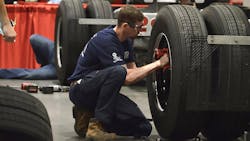Smart tools
In the case of smart tools, frequent calibration notifications can point to larger problems, like certain shop practices or repair behaviors that may require correction or adjustment from a management perspective. For example, if a smart tool is signaling that it requires calibration, but it’s only been 6 months since the last one, the tool could be getting mishandled or overused.
“Maybe you need to have a discussion with some of the guys on the floor about how they're handling the tool and what they're using it for,” Imhoff suggested.
Although calibration will always be an essential aspect of repair work, taking good care of tools can minimize inaccurate performance mid-repair and the need for unscheduled calibrations. Things like rough handling and overuse can impact the ability of a tool to do its job properly.
“Especially with the torque wrench—If you drop it, set it down too hard, if it falls off the truck,” said Dillon Grimes, a mobile diesel mechanic with Cox Automotive. “I’d say that nine times out of 10 if something loses calibration, it’s probably mishandling.”
Rod Imhoff, key account manager for Chicago Pneumatic, noted that for certain tools, everything down to the specifics of storage can have an impact on the tool’s calibration, explaining that a standard click wrench, for example, shouldn’t be left “loaded.”
“You don’t want to leave it set, because the spring that’s controlling the setting of the torque when left in that position weakens over time or loses its retention,” he cautioned, “so you need to leave it unset.”
This is because if a technician were to find a tool already set in the shop, there are a number of unknowns that can influence its accuracy.
Read more: Product Showcase 2025: Tools & Personal Gear
“You don’t know how long it’s been in that position; you don’t know if the tool’s been dropped or if it was laid down,” he continued. “There’s really no way of ever knowing from looking at the tool or just generally using the tool if it’s at 10%, 5%, 50% of the torque that it’s specifically set at.”
The environment within the shop is another element to consider.
“It isn’t easy to keep wheel torque tools clean and dry, but it plays a big role,” Kevin Rohlwing, chief technical officer for the Tire Industry Association, stated.
Regarding humidity, for example, Imhoff explained that as with any metal item, “whether it be aluminum or steel, you’re going to get some expansion and shrinkage and temperature change in [a humid environment], not to mention what the moisture can do to the inside of a tool as well.”
He offered a few solutions, such as investing in high-quality, industrial-strength tools that are water-resistant and sealed as well as controlling the shop environment as best as possible for tool longevity.
The bottom line, however, is that tools will need to be calibrated regardless of how well they’re treated, so the best course of action is to be as prepared as possible for when the time comes.
“The fact is, when you have a tool that needs to be calibrated, there's going to be some downtime, even if you're on your regular schedule,” said Imhoff. “When you ship that off to get it calibrated, you're going to be without a tool for a number of days.”
This is critical if the shop only has one of a particular tool, especially in the event that it goes out mid-service. It may not be as much of an issue for larger shops though, as they likely have multiples. A tech could simply grab another tool that is operating properly and use that to finish the job. Either way, having a plan in place is recommended.
“If that requires you to have two of these tools, you buy two. If you want to fall back on a torque stick or whatever you're going to use, that's fine, too, but you need to have some kind of backup plan,” Imhoff concluded.
About the Author

Lucas Roberto
Lucas Roberto is an Associate Editor for Fleet Maintenance magazine. He has written and produced multimedia content over the past few years and is a newcomer to the commercial vehicle industry. He holds a bachelor's in media production and a master's in communication from High Point University in North Carolina.
